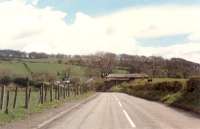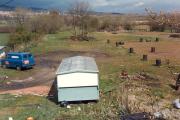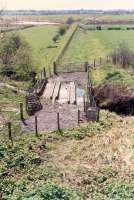Bairds of Gartshore's Railway
Introduction
This private line, actually a small network of lines, ran north from collieries alongside the Edinburgh and Glasgow Railway to serve further collieries around Twechar and Kilsyth. It was owned by the owners of the Gartsherrie Iron Works.
Portions of line and locations
This line is divided into a number of portions.
Gartshore to Twechar
This portion of the line ran from the Gartshore mine sidings alongside the Edinburgh and Glasgow Railway north west to reach Twechar where there were further mines and a locomotive shed and works. To the north the line crossed the Forth and Clyde Canal by a swing bridge before dividing into branches to Twechar station and Dumbreck Colliery, coke works and a colliery south of Kilsyth, and several mines and quarries to the south and east of Kilsyth. To the west a line ran to the St Flanan Mine.
There are loops on either side of the Edinburgh and Glasgow Railway at Gartshore, historically the interchange point with the Bairds of Gartshore's Railway which ran north serving many coal pits. The Gartshore Exchange Sidings were just to the north.
...
See also
Edinburgh and Glasgow Railway

Ewan Crawford //1990
This coke works was built by William Bard and Co of the Garthserrie Iron Works alongside Gartshore Pits Nos 5 and 6. Because the Gartsherrie Iron Works employed the hot blast method initially there were no coke ovens at the works, coal being used directly. Later coke was used and coke ovens were erected at Gartshore and a number of other locations such as Haugh Coke Ovens and ...
More detailsThe locomotive shed and works for the Bairds of Gartshore's Railway system was located south of the Forth and Clyde Canal a short distance from the Twechar Swing Bridge over the canal. Several locomotives were maintained here.
...
This William Baird & Co pit was south of the Forth and Clyde Canal. Underground it was linked to Twechar Colliery Pit No 1, north of the canal, for which it provided a ventilation upcast and an escape route. The pit was directly east of the Twechar Shed and Works.
...
This William Baird & Co pit was on the north bank of the Forth and Clyde Canal, east of Twechar Swing Bridge. It was served by the Bairds of Gartshore's Railway, being approached the north. Its bing was to the north.
...
Twechar to Dumbreck
This William Baird & Co pit was on the north bank of the Forth and Clyde Canal, east of Twechar Swing Bridge. It was served by the Bairds of Gartshore's Railway, being approached the north. Its bing was to the north.
...
This was a typical small North British Railway style station, with a building typical of the NBR. However there was a large yard on the south side of the line, accessed from the east.
...
See also
Kelvin Valley Railway

Ewan Crawford //1990

Ewan Crawford //1990

Ewan Crawford //1990
Twechar to Kilsyth
This William Baird & Co pit was on the north bank of the Forth and Clyde Canal, east of Twechar Swing Bridge. It was served by the Bairds of Gartshore's Railway, being approached the north. Its bing was to the north.
...
This was the junction where the Kilsyth and Bonnybridge Railway met the Kelvin Valley Railway. Kilsyth Shed was located to the north, approached from the junction to the east.
...
See also
Kelvin Valley Railway
Kilsyth and Bonnybridge Railway

Ewan Crawford //1991
Twechar to Colzium
This William Baird & Co pit was on the north bank of the Forth and Clyde Canal, east of Twechar Swing Bridge. It was served by the Bairds of Gartshore's Railway, being approached the north. Its bing was to the north.
...
Twechar to St Flanan
The locomotive shed and works for the Bairds of Gartshore's Railway system was located south of the Forth and Clyde Canal a short distance from the Twechar Swing Bridge over the canal. Several locomotives were maintained here.
...
This colliery was on the south bank of the Forth and Clyde Canal west of Twechar. It was sunk for William Baird & Co of the Gartsherrie Iron Works for coking coal - the coke ovens for several mines served by their private line were at Haugh Coke Ovens (Kilsyth), Gartshore Coke Ovens and other locations. An alternative spelling is St Flanan. The colliery consisted of pits nos 1 ...
More details

